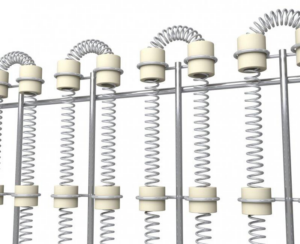Do Electric Heating Coil Materials Matter?
Last updated on May 8th, 2025 at 05:55 am
Not all materials in heating elements are made equal. Industrialists rely on various metal alloys, ceramics, and semiconductor materials in heating coils for different purposes and effects. This post will highlight these differences and which ones work best for particular applications.
Why Materials in Heater Coil Elements Matter?
 A heating element needs to do more than provide heat. It must also withstand harsh conditions within the heater itself and the environments in which it operates.
A heating element needs to do more than provide heat. It must also withstand harsh conditions within the heater itself and the environments in which it operates.
If not, the heating element will succumb to premature wear-and-tear, leading to malfunction and failure of the hardware. With that said, there are some common conditions that heating coil elements need to withstand to function appropriately in the long and short term.
Conditions heater coil elements must withstand
- Extremely high temperature
- Highly corrosive medium
- Resistance to oxidation
- Low oxygen
- High salinity
- Poor circulation
Depending on the industry or application, it’s impossible to avoid these conditions altogether. That means the materials in your heater coil elements need strength and durability to tolerate harsh conditions.
How different materials affect heating quality/lifespan?
Choosing an electric heater with the right heater coil elements is crucial. It will mean the difference between having a durable unit versus one with a short shelf life. Of course, that durability (or lack thereof) influences the energy efficiency and performance of the heater. Additionally, some common materials confer greater durability and efficiency than others.
Stainless steel
Stainless steel is the standard material in heater coil elements. It’s made of steel alloy with typically 13% to 26% chromium. The reason manufacturers use stainless steel in electric heater coils is its ability to resist oxidation. It’s the standard choice as a water heating element and other liquids with a similar chemical composition to water. But it isn’t perfect. Stainless steel tends to degrade in the presence of low oxygen, high salinity, or poor circulation.
Nickel-chrome (Inconel®)
Nickel-chrome, a.k.a, Inconel®, is a manufactured alloy that can withstand temperatures in cryogenic ranges up to 1400°C. Some forms of this metal also have a high tensile strength, ranging from 103 to 160 ksi.
When heater coil elements made with Inconel® heat up for the first time, they react with oxygen in the air. The result is a layer of chromium oxide on the element’s surface. This chromium oxide coating protects the heater coil element from oxidation, breakage, and heat damage.
Nickel-chrome has a high resistance level compared to other allows, making it ideal for converting electrical energy into heat. This material works for applications that involve extremely high temperatures and corrosion. They include:
- Petrochemical applications
- Offshore oil drilling
- Rocket engines, spacecraft, gas turbines
- Pollution control
- Nuclear reactor chambers
Nickel-iron-chromium (Incoloy®)
Incoloy®, an alloy composed of nickel, iron, and chromium, is a low-cost metal suitable for high temperatures up to 1232°C. It is cost-effective since it contains less nickel than other alloys (such as Inconel®). It’s also easy to make Incoloy — manufacturers can produce it as easily as stainless steel.
Incoloy® comes in various grades of strength. Basic forms are cheaper but more expensive forms of the alloy offer increased protection against structural deterioration and corrosion.
Specific grades of this alloy, such as Incoloy® 825, can withstand highly corrosive substances such as sulphuric and phosphoric acids. In general, Incoloy® is suitable for applications including:
- Heating-element sheathing
- Tubing in nuclear steam generators
- Oil/gas piping
- Industrial furnaces
- Heat exchangers
- Acid production
- Petrochemical processing
Semiconductors and other compounds
Metals aren’t the only materials used in heater coil elements. Other heating elements contain semiconductors, intermetallic compounds, and even ceramics. For example, silicon carbide is a semiconductor material that can withstand temperatures up to 1625°C and is highly resistant to oxidation.
Other heater coil elements incorporate molybdenum disilicide, an intermetallic compound. It can maintain its integrity under temperatures up to 1800°C, corrosion, oxidation, and has low thermal expansion.
These materials can also serve as viable alternatives (or upgrades) to metallic heater coil elements. Of course, ensuring they suit your industrial applications is critical.
Also read: Metal Alloys Used in Immersion Heaters for Industrial Applications
Wattco recommendations for heating elements
For heating in less extreme environments, you can rely on an electric heating coil made with traditional stainless steel (or other metals). That includes water heating or the heating of other liquids and stable gases.
However, you’ll want to opt for a stronger alloy for industrial applications with extreme corrosion, oxidation, or temperatures. They include the likes of Inconel® and Incoloy® mentioned above, although other options may be more suitable.
If you’re looking for the right electric heater coil type, get in touch with us. Here at Wattco, we manufacture heater coil elements that can withstand the harshest environments and we will recommend the best ones for your industry.
